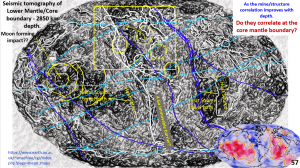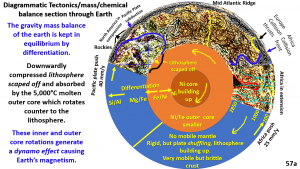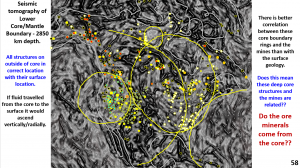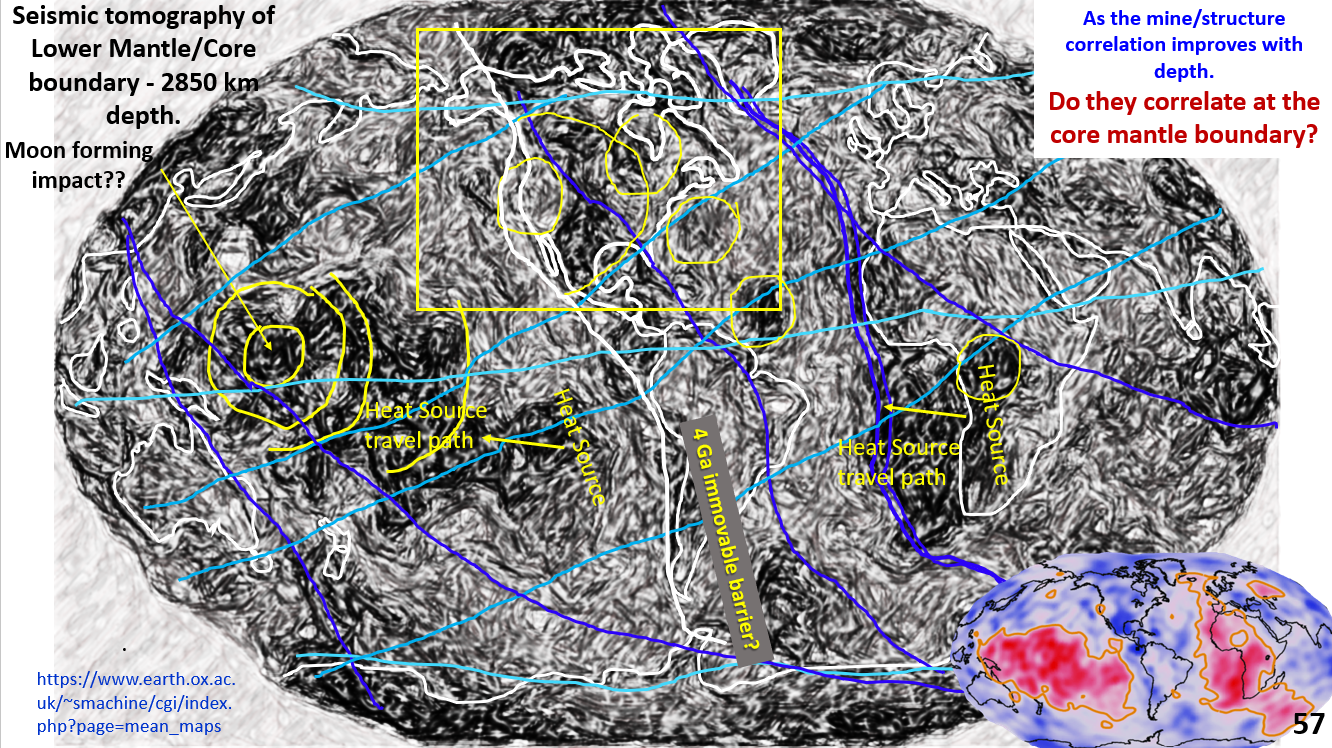View the Webinar at; https://www.ausimm.com/videos/community-event/south-west-wageoscience-society—digital-tech-talk-new-discoveries-in-the-structural-geology-mineralization–exploration-targeting-of-north-america/ .

Figure 57. Outer Core/Lithosphere Boundary interpreted, enhanced seismic tomographic plan.This is a new area of my research (you see it first here!), tracing the surface structures right down to the Core Mantle Boundary (CMB).
This plan of enhanced seismic tomography tomography was derived from the seismic tomography plan down on the right-hand corner which was a very broad look at seismic tomography of the Core Mantle Boundary (Mingming et.al., 2017). Despite this being a very fuzzy, colour contour image good structural geology was obtained.
Result? The seismic tomography of the Core Mantle Boundary shows linear and ring structures that relate to those on the surface and in the 200 km depth tomography. How can structures 2,850 km deep propagate to the surface??
Structural geology.
1. There are strong WNW ‘structures’ (blue) that correlate with the Tethyan Spiral (O’Driscoll 1980) at the surface.
2. The tomography is structurally divided in half along the west boundary of the American continents. This correlates to the 4 billion year old immovable boundary (white NNW line) seen in the 200 km depth tomography and in all of the crust to core cross-sections of North and South America (see figure 56, part 11).
3. The third component of the structures observed at 200 km depth, the ultra strong ENE to NE linears, are present as a series of ENE arcs and NE linears that encircle the Earth but are still strongest where cutting through the Pacific, North America and Northern Europe. The almost exact correlation of these three structural features cannot be coincidence!
Why, and how, can these structures correlate under the current hypothesis of Plate Tectonics driven by a mobile mantle? – they can’t! This is the first time that ultra-detailed structural geology of deep Earth has been used in constructing a model of Earth’s evolution down to the Core Mantle Boundary. The conclusions made here are more likely to be correct than conclusions based on the very fuzzy, non-structural geology data currently used.
We will be looking at the relationship of the mines under North America to structures on the CMB later (yellow rectangle).
The fact that these same structural features are in the same geographic relationship to the continents above suggests that overall there has been little movement of the surface of Earth with respect to the CMB. How can this occur?? It is problematical given the obvious movement of the Earth’s surface plates?? The only reason this lack of movement in the continents could happen is that the 4 billion year immovable barrier is just that – immovable – a dam!
The next diagram shows how this is possible.

Earth Evolution. By what mechanism can the earth above the CMB be immovable when the plates at the surface move?
The components of the Earth mass-balance are shown in the diagram above and their description is below.
The seismic tomography traverse from the west coast of North America, through Europe to Africa is shown on a diagrammatic image of the earth. The distances are correct. Note the brittle structures extending from the crust to the outer core suggesting rigidity.
I reason, from my research into the structural geology of all the continents and the relative movements of the Earth’s plates, that that the continents have remained relatively static. However, the Pacific plate has always been upwelling and expanding from the CMB upwards. Why?
It is generally recognised this is the site where the Mars sized bolide that spalled off the moon impacted (yellow rings in Pacific in figure 57). This would create a huge breach in the CMB and most likely be a long-lived heat escape.
The immovable boundary along the Americas’ west coast (figure 57a, 10 o’clock) stops eastward movement and so the continents have been compressed onto this immovable barrier from the west.
Asia, Europe and Africa are compressed by the eastern side of the Pacific ‘ring of fire’ from the far east (2 o’clock). This results in pop-up and pop-down structures over all of these continents.
The best known pop-up structures are the Andes/Rockies in the Americas (11 o’clock) and the Alps/Caucasus/Urals and Himalayas in the Africa/Asia super-continent (2 o’clock).
Erosion removes the pop-up mountains and the reverse spinning 5,000 C semi-liquid outer core would slice off the pop-down material like a laser cutter! This relieves the plate movement pressure and enables the continents to remain relatively static and still enable the observed plate movement to continue indefinitely.
19. North America seismic tomography at 2,850 km depth with mines overlaid.

Mineralisation. The rationale behind tracing the surface structures down to the core is that it would be surprising if the mineralising fluids only started halfway down to the core in relatively static P/T conditions. It would be more logical that they would start at the core where there are huge pressure, temperature, rheology and chemical differences.
These are the best conditions for forming ore at the surface and there is reason to believe that would be the best conditions to separate material into mineral rich fluids at any depth within the Earth.
So the surface mines were super-imposed onto the Core Mantle Boundary to see if they line up with the structures seen at that depth.
The thinking behind this is that, if the mines do start at the hotspots on the Core Mantle Boundary, then the fluids, because of their great heat difference to the surrounding rock, would rise vertically (radially), to the surface and not go off at a great angle to the vertical. Thus if the mines on the surface line up with the same type structures on the Core Mantle Boundary this will support this hypothesis of the hot mineralising fluids originating at the CMB. It makes a lot of sense to me!
This figure shows the rings on the CMB (yellow) as they would be located under the North American continent. The rings and linears relate to rings and linears on the surface and at various depths in seismic tomography. The mines do relate to the deep rings and especially the intersection of these deep rings and the strongest linears.
The diamond mines in particular are associated with rings on the CMB which confirms my belief in the vertical travel path of the deep mineralising fluids.
The mechanism for deep-seated mineralisation would be super heated fluids from the core scavenging metals either from the core as they ascend and depositing them further up.
This process could be repeated many times as the earth jolts under the Late Heavy Bombardment and other later shocks (Vredefort, Chicxulub etc). This would be the reason that most of the giant mineral fields are multi element and deposited during multiple phases of mineralisation.
I suggest that if you could take a section of the core from the surface right to the Core Mantle Boundary that you would find depletion and mineralisation all the way.
I find this research quite fascinating. Where it leads to in Exploration Targeting using the CMB I’m not sure, but the concept should be valid.
Follow this research and share with your colleagues who want to learn something new and exciting, and use it to go exploring.
Happy head scratching 🙂 🙂
Bob Watchorn

